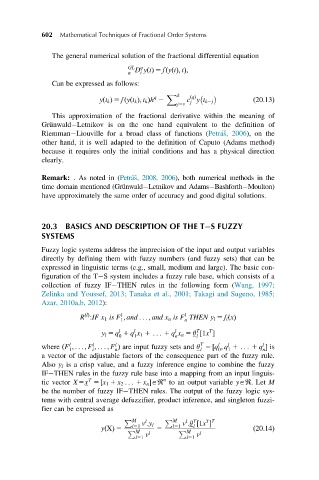Page 631 - Mathematical Techniques of Fractional Order Systems
P. 631
602 Mathematical Techniques of Fractional Order Systems
The general numerical solution of the fractional differential equation
GL D yðtÞ 5 fðyðtÞ; tÞ;
q
a t
Can be expressed as follows:
X k
q
yt k ðÞ 5 fy t k ðÞ; t k Þh 2 c yt k2j ð20:13Þ
q ðÞ
ð
j5v j
This approximation of the fractional derivative within the meaning of
Gru ¨nwald Letnikov is on the one hand equivalent to the definition of
Riemman Liouville for a broad class of functions (Petra ´ˇ s, 2006), on the
other hand, it is well adapted to the definition of Caputo (Adams method)
because it requires only the initial conditions and has a physical direction
clearly.
Remark: .As noted in (Petra ´ˇ s, 2008, 2006), both numerical methods in the
time domain mentioned (Gru ¨nwald Letnikov and Adams Bashforth Moulton)
have approximately the same order of accuracy and good digital solutions.
20.3 BASICS AND DESCRIPTION OF THE T S FUZZY
SYSTEMS
Fuzzy logic systems address the imprecision of the input and output variables
directly by defining them with fuzzy numbers (and fuzzy sets) that can be
expressed in linguistic terms (e.g., small, medium and large). The basic con-
figuration of the T S system includes a fuzzy rule base, which consists of a
collection of fuzzy IF THEN rules in the following form (Wang, 1997;
Zelinka and Youssef, 2013; Tanaka et al., 2001; Takagi and Sugeno, 1985;
Azar, 2010a,b, 2012):
l ðÞ l l
R :IF x 1 is F ; and ... ; and x n is F THEN y l 5 f i xðÞ
1 n
l l l T T
y l 5 q 1 q x 1 1 ... 1 q x n 5 θ ½1x
0 1 n l
T
l
l
l
l
l
l
where ðF ; ... ; F ; ... ; F Þ are input fuzzy sets and θ 5 ½q ; q 1 ... 1 q is
1 i n l 0 1 n
a vector of the adjustable factors of the consequence part of the fuzzy rule.
Also y l is a crisp value, and a fuzzy inference engine to combine the fuzzy
IF THEN rules in the fuzzy rule base into a mapping from an input linguis-
n
T
tic vector X5x 5 ½x 1 1 x 2 ... 1 x n AR to an output variable yAR. Let M
be the number of fuzzy IF THEN rules. The output of the fuzzy logic sys-
tems with central average defuzzifier, product inference, and singleton fuzzi-
fier can be expressed as
P M l P M l T T T
l51 v :y l 5 l51 v :θ ½1x
l
M l P M l ð20:14Þ
y XðÞ 5 P
l51 v l51 v

